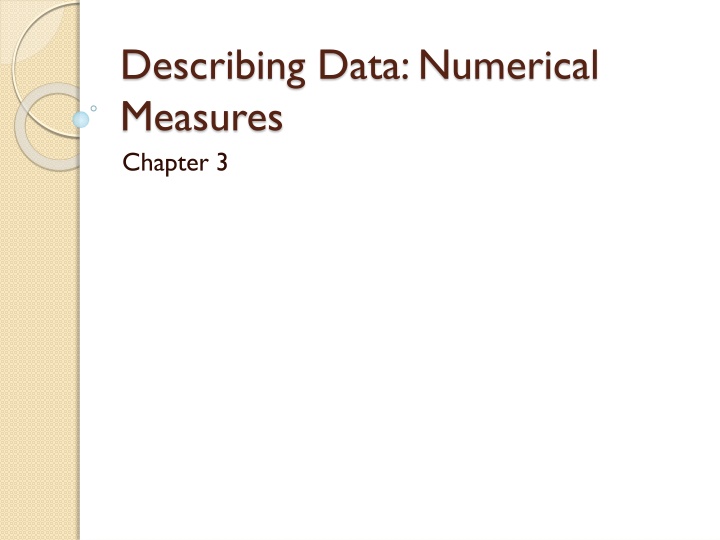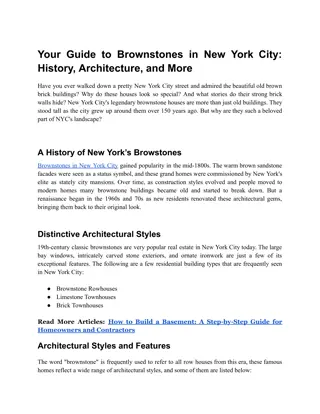
Descriptive Statistics: Central Tendency and Variability Measures
Explore the world of numerical measures in statistics with a focus on central tendency and variability measures. Learn about mean, median, mode, range, variance, standard deviation, and more to gain insights into data analysis and interpretation.
Download Presentation

Please find below an Image/Link to download the presentation.
The content on the website is provided AS IS for your information and personal use only. It may not be sold, licensed, or shared on other websites without obtaining consent from the author. If you encounter any issues during the download, it is possible that the publisher has removed the file from their server.
You are allowed to download the files provided on this website for personal or commercial use, subject to the condition that they are used lawfully. All files are the property of their respective owners.
The content on the website is provided AS IS for your information and personal use only. It may not be sold, licensed, or shared on other websites without obtaining consent from the author.
E N D
Presentation Transcript
Describing Data: Numerical Measures Chapter 3
Introduction Measures of central tendency (location) Mean (average, or arithmetic mean); Median; Mode; Geometric mean; Measures of dispersion (variability) Range; Mean deviation; Variance; Standard deviation; Quartiles, deciles, and percentiles; Measures of shape: Skewness; Box plots; Measures of central tendency and variability: Grouped data
Measures of central tendency mean Measures of central tendency yields information about the center, or middle part, of a group of numbers; Arithmetic mean is the average of a group of numbers population mean sample mean Weighted mean: a special case of the arithmetic mean, it occurs when several observations are of the same value x
Mean (average) Population mean; = sum of all the values in the population/number of values in the population Sample mean; = the sum of all the values in the sample/the number of values in the sample: Weighted mean; The weighted mean of a set of numbers X1, X2, ..., Xn, with corresponding weights w1, w2, ...,wn, is computed from the following formula: ( w w + X = N X = X n + + + ... w X w X w X ) = 1 1 ( 2 2 n n X + ... w w ) 1 2 n
Mean - Example 1 The Kiers family owns four cars. The following is the current mileage on each of the four cars: 56 000, 23 000, 42 000, 73000 Find the mean.
Example 1 -Answer = X + + 56 000 ... 73 000 = = 48 500 4 N
Mean - Example 2 A sample of five executives received the following bonus last year ($1000): 14.0, 15.0, 17.0, 16.0, 15.0 Find the mean + + + 14 15 ... 15 77 X = = = = 15 4 . X 5 5 n
Mean - Example 3 During a one hour period on a hot Saturday afternoon Chris served fifty drinks. He sold five drinks for $0.50 each, fifteen for $0.75 each, fifteen for $0.90 each, and fifteen for $1.15 each. Compute the weighted mean of the price of the drinks. + + + 5 ($ . 0 50 ) 15 ($ . 0 75 + ) 15 ($ . 0 + 90 ) 15 ($ . 1 15 ) = X w + 5 15 15 15 44 $ 50 . = = . 0 $ 89 50
Measure of location - Median The Median is the middle value in an ordered array of numbers: 5 4 9 13 11=>4 5 9 11 13=> 9 is the median; For an odd set of values, the median is the middle number; For an even set of values, the median will be the average of the two middle numbers.
Median Example 1 The ages for a sample of five college students are: 21, 25, 19, 20, 22 Arranging the data in ascending order gives: 19, 20, 21, 22, 25. Thus the median is 21.
Median Example 2 The penalty minutes of four hockey players are: 76, 73, 80, 75 Arranging the data in ascending order gives: 73, 75, 76, 80. Thus the median is 75.5, found by (75+76)/2.
Measure of location - Mode The mode is the value of that appears most frequently in a set of data. It tells where most data are clustered. EXAMPLE :The exam scores for ten students are: 81, 93, 84, 75, 68, 87, 81, 75, 81, 87. Because the score of 81 occurs the most often, it is the mode. In business, mode often is used to determine sizes of clothing, and preferences.
Measure of location - Mode If two most frequently occurring value => bimodal; If more than two most frequently occurring value => multimodal;
Measure of location - Geometric mean The geometric mean (GM) of a set of n numbers is defined as the nth root of the product of the n numbers, . The formula is: =n ( )( 1 )( )...( 3 ) 1 GM X X X n X 2 Application 1: find the average of percentage increases; Ex: 5% increase in salary this year and a 15% increase next year. What is the average annual percentage increase? 10%, no, it s 9.886%. Note, for negative percentage such as -40%, use 1.0 -0.4 = 0.6 in the formula.
Geometric mean Example 1 The percent increase in sales , for the last five years at Combs Cosmetics are 8, 12, 14, 26 and 5, find the average percentage increase.
Example 1-Answer = . 1 ( . 1 ( . 1 ( . 1 ( = . 1 ( 08 ) 12 ) 14 ) 26 ) 05 ) 1 . 0 128 x 5
Geometric mean Example 2 The interest rate on a bond for 3 successive year was 5%, 41%, and 4%, find the average interest rate x. = 1547 . 1 = = . 1 ( 05 . 1 )( 41 . 1 )( 04 ) 1 1 1547 . 0 x 3 Then the average interest rate is 15.47%. For the above example: the arithmetic mean is (1.05+1.41+1.04)/3 = 1.1667 or 16.67% The GM gives the true average rate of return, while the arithmetic mean would overstates the true average.
Geometric mean Application 2: calculate the percent increase from one time period to another, given the beginning value and end value. ( Value at end of period) = n 1 GM (Value beginning at of period) Bi-weekly income increases from $2000 to $3000 from end of 2005 to end of 2007, what is the annual percentage increase?
Geometric mean Example The total population of British Columbia increased from 3,874,276 in 1995 to 4, 254,522 in 2005, find the annual population increase? 4254522 10 = = 1 00941 . GM 3874276 That is, the annual population increase is 0.941%.
Exercise 1 For a sample of 10 households, the following are the number of people living in each household: 2, 3, 1, 2, 6, 4, 2, 1, 5, 3; Compute the mean, median, mode; The percent increase in sales, for the last four years at Combs Cosmetics are: 4.91, 5.75, 8.12, and 21.60. Find the geometric percent increase; Find the arithmetic percent increase; Is the arithmetic mean equal to or greater than the geometric mean?
Measures of dispersion Range; Mean deviation; Variance; Standard deviation; Skewness; Quartiles, deciles, and percentiles
Why study dispersion Measure how wide the data are distributed; Comparing two distributions that might have the same mean, median and mode;
Measures of dispersion - Range The range is the difference between the largest and the smallest value. Only two values are used in its calculation. It is influenced by extreme values only.
Range Example The number of books sold in a bookstore during the five days of a week are: 105, 97, 101, 106, 103 Find the range and the mean. Range = 106 97 = 9 Mean = (105+97+101+106+103)/5=512/5=102
Measures of dispersion - Mean deviation The Mean Deviation is the mean of the absolute values of the deviations from the arithmetic mean. X MD = X n Where : x is the value of each observation. is the arithmetic mean of the values. n is the number of observations in the sample. | | indicates the absolute value. MD tells us the average distance between X and its mean. Example: hourly production (48, 49, 50, 51, 52) and (40, 47, 50, 53, 60), the larger the MD is, the wider(higher) the dispersion (variability) is. X
Mean deviation 105, 97, 101, 106, 103, find the MD. To find the mean deviation, first find the average sales: 512= = = n X 102 4 . X 5 The MD is: + + X X 105 102 4 . ... 103 102 4 . = = MD 5 n 13 6 . = = . 2 72 5
Mean deviation Pro: MD uses all the values in the computation, comparing range; Con: absolute value is difficult to work with => in stead of taking absolute values, we take squares of the deviations=> variance
Variance and standard deviation The population variance is the arithmetic mean of the squared deviations from the population mean. ( ) 2 x 2 x 2 ( ) X = 2 N or = 2 N N is called sigma squared. is the arithmetic mean of the population. is the value of an observation. is the number of observations. 2 X N
Variance and standard deviation Population standard deviation is the square root of the population variance If the population variance is 236, the population standard deviation is 15.36, found by 2 = = = 236 15 36 .
Variance and standard deviation Sample variance 2 ( ) X X = 2 s 1 n ( ) 2 X Or 2 X n = 2 s 1 n Sample deviation s = 2s
Variance Pro: easier to compute than MD; Con: variance is expressed in squared units of measurement, which is difficult to interpret. Example, production cost in squared dollars => need of standard deviation, which is the square root of variance;
Variance and standard deviation- Example 1 The hourly wages earned by a sample of five students are: $7, $5, $11, $8, $6, find the sample SD. 37 X = = = 4 . 7 X 5 X n ( ) ( ) ( ) 2 2 2 4 . 7 + + 4 . 7 7 ... 6 X = = 2 s 1 5 1 n 21 2 . s = = 3 . 5 5 1 = = = 2 3 . 5 3 . 2 s
Variance and standard deviation Example-2 The ages of the Dunn family are: 2, 18, 34, 42 What is the population variance? 96 X = = = 24 4 N ( ) ( ) 2 2 N + + 2 ( ) 2 24 ... 42 24 X = = 2 4 944 = = 236 4
The coefficient of variation The coefficient of variation is the ratio of the standard deviation to the arithmetic mean, expressed as a percentage. CV is useful in comparing variability for data with different units: comparing a set of annual income with CV=18% with the length of service with CV=29%; No comparison using variance or standard deviation due to different units. It is also sometimes used as a measure of risk in stock market. Five weeks average prices for stock A are 57,68,64,71,62, mean=$64.4, sd=$4.84, CV=7.5%; Five weeks average prices for stock B are 12, 17, 8, 15, and 13, mean=$13, sd=$3.03, CV=23.3%. Which stock is more risky using price variability as a measure of risk?
Quartiles, Deciles, and Percentiles Median divide all the observations into two parts; Quartiles divide them into four parts; Deciles divide them into 10 parts; Percentiles divide them into 100 parts; Location of a percentile: P = ) 1 + ( Lp n 100 Note: order data first;
Quartiles, Deciles, and Percentiles Determine the median and the values corresponding to the first and third quartiles in the following data: 46 47 49 49 51 53 54 54 55 55 59 50 = ) 1 + = = = 11 ( 6 53 L median 50 100 25 = ) 1 + = = = 11 ( 3 49 L Q 25 1 100 75 = ) 1 + = = = 11 ( 9 55 L Q 75 3 100 Interquartile Range (IQR) The IQR =Q3- Q1 =55-49=6, it includes the middle 50 percent of the observations. It is useful when we are more interested in the middle part of the data => Real estates.
MEASURES OF SHAPE - SKEWNESS Skewness is the measure of the lack of symmetry of the distribution
Skewness The coefficient of skewness can be calculated using: 3 X Median - ( ) = sk sd Where sd is standard deviation; sk can range from -3.00 up to 3.00. A value of 0 indicates a symmetric distribution. When sk <0, negatively skewed; When sk >0, positively skewed.
Skewness -Example A sample of five data entry clerks employed in the customer service department of a large pharmaceutical distribution company revised the following number of records last hour: 73, 98, 60, 92, and 84. Find the mean, median, and the stand deviation; Compute coefficient of skewness; What is your conclusion regarding the skewness of the data? Mean: 81.4; Median: 84; SD: 15.19; Sk = 0.51; Positively skewed;
Box Plots A box plot is a graphical display, based on quartiles, that helps to picture a set of data. Five pieces of data are needed to construct a box plot: the minimum value, the first quartile, the median, the third quartile, and the maximum value.
Box plots 20 pizza delivery generated the following data: Min value = 13 min Q1=15 min Median = 18 min Q3= 22min Max value =30 min
Box Plots The uses of box plots: Find outliers if any, values outside of Q1- 1.5IQR to Q3+1.5IQR to determine whether a distribution is skewed=>median on the right side of the box, then negatively skewed; median on the left side, then positively skewed.
Grouped data Measures of central tendency: Mean; Median; Mode; Measures of variability: variance and standard deviation;
Grouped data - Mean The table gives the unemployment rate over the past 40 years; Use midpoint of each class interval => similar to the calculation of weighted mean Mean = (2 16+4 2+6 5+8 2+10 9+12 6)/40=6.2%
Grouped data - Median Median: the value attributed to the middle point of the data. Middle point: Lp= (n+1)P/100=20.5; Median = Where L is the lower point of the class containing the median; L=5% f is the frequency of the class containing the median; f=5; fcis the cumulative frequency of classes preceding the class containing the median; fc= 16+2 =18; i is the width of the class containing the median, i=7-5=2% n f c 2 + ( ) L i f 40 18 2 Median = 2 + = + = 5 2 5 2 8 . 5 % 5 5
Grouped data - Mode The class midpoint of the modal class (the interval with the highest frequency). Modal class is 1 to under 3, therefore, Mode: 2%
Grouped data -Variability Class interval 1-under 3 3-under 5 5-under 7 7-under 9 9-under 11 11-under 13 Total f 16 2 4 3 9 6 M 2 4 6 8 10 12 fM 32 8 24 24 90 72 250 fM2 64 32 144 192 900 864 2,196 Population variance and standard deviation Original formula ( ) N Computational Version ( ) 2 2 f M fM = 2 2 fM N = 2 N = 2 Where M is the midpoint of each class.
Grouped data -Variability Sample variance and standard deviation Original formula Computational Version ( ) ( n ) = 2 2 f M x fM = 2 2 fM s n 1 2 s 1 n s = 2s 2 ( ) fM 2 250 = 2 2196 fM 40 n = = 2 16 24 . s 1 40 1 n = = = 2 16 24 . . 4 03 s s




















